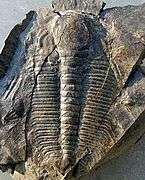Hydrocephalus (trilobite)
Hydrocephalus ("water head") is an extinct genus of redlichiid trilobite that was very common during the Middle Cambrian of Eurasia and North America, which lasted from 508 to 497 million years ago. This trilobite is up to 20 cm long and more widely built than others of the time. In comparison to other members of its family, its glabella appears swollen.
| Hydrocephalus | |
|---|---|
| Hydrocephalus carens at the National Museum (Prague) | |
| Scientific classification | |
| Kingdom: | |
| Phylum: | |
| Class: | |
| Order: | |
| Suborder: | |
| Family: | |
| Genus: | Hydrocephalus Barrande, 1846 |
| species | |
| |
| Synonyms | |
|
Phlysacium Hawle et Corda, 1847
| |
Gallery
 Hydrocephalus minor from Jince (Czech Republic)
Hydrocephalus minor from Jince (Czech Republic) Free cheek of H. carens, 33mm between the tips
Free cheek of H. carens, 33mm between the tips
gollark: Oops.
gollark: d
gollark: Pretty well, the questions were generally easy but slightly time-constrained.
gollark: Since it's more furtherer, it's better.
gollark: I underwent my first exam, which is for Further Maths.
References
- Rushton, A.W.A.; Weidner, T. (2007). "The Middle Cambrian paradoxidid trilobite Hydrocephalus from Jämtland, central Sweden" (PDF). Acta Geologica Polonica. 57 (4): 391–401. Retrieved 30 March 2013.
| Wikispecies has information related to Hydrocephalus |
This article is issued from Wikipedia. The text is licensed under Creative Commons - Attribution - Sharealike. Additional terms may apply for the media files.